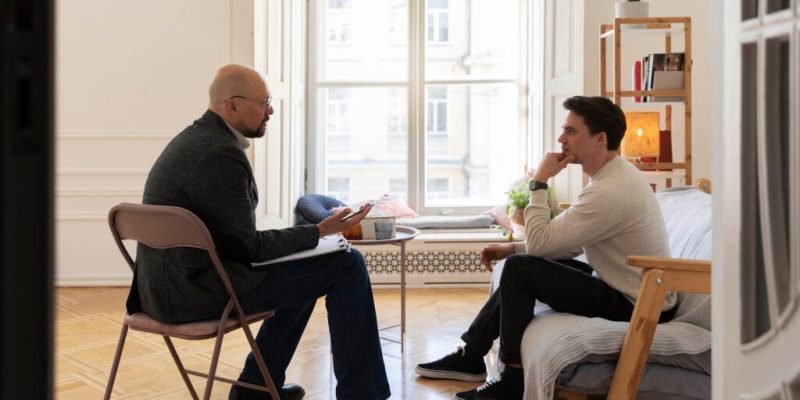Brief strategic psychotherapy is a model implemented by the Italian psychologist Giorgio Nardone. It aims to respond to the needs of the patient/client/consultant in an extremely short time. To do this, the therapist gives up exploring the client’s past and devotes attention to the present.
In brief strategic psychotherapy, therapists use specific techniques to create rapid changes in thinking and behavior. They use the following strategies:
- The paradox. It’s used to challenge the logic of the problem and change the way the patient perceives it. For example, the therapist urges them to try to do the opposite of what they’ve been doing to date to solve their problem.
- Reframing of the problems. The therapist helps the patient change their perception of the problem to see it in a different, more positive, and less threatening way.
- Surprise. The therapist interrupts the patient’s thought and behavior patterns, thus encouraging flexibility. They seek to create an unexpected or surprising situation that makes the patient see that there are other ways of thinking or acting when faced with problems.
- Diversion of attention from the problem. The therapist diverts the patient’s attention away from the description of the problem and makes them focus on the search for solutions. They encourage the patient to talk about certain exceptions when it comes to their problems. For instance, when they don’t occur or are less intense.
- Symptoms prescription. The therapist suggests the patient intentionally perform or exaggerate their problem behavior or symptom. This technique makes them realize that they’re in control of their behavior. It can help reduce the anxiety associated with the symptom.
Reality
Brief strategic psychotherapy invites reflections such as “What’s ‘reality’?” or “How many ‘realities’ are there?”. Taking into account the fact that the human being is an organism that ‘constructs its own reality’, this will tend to be subjective, unique, and particular to each individual. With such a premise, Nardone’s model was born. It states that ‘objective reality’ is a chimera (Bartoli et al., 2023).
“The solution is not the end of the problem, but the beginning of something new.”
-Giorgio Nardone-
Brief strategic psychotherapy
This therapy arose thanks to the developments of the famous Mental Research Institute (Palo Alto, California, US), the cradle of systemic psychotherapy. It’s a solution-focused approach based on the present moment, that attends to the origins of the patient.
Through the use of various strategies, the therapist seeks to break the vicious circle in which the patient finds themselves. This is because we often have a tendency to try and fix problems with similar methods but fail.
The objective focuses on promoting alternative solutions that can modify what Giorgio Nardone calls the reactive perceptual system. We’ll explain this later. It’s achieved through prescriptions, metaphorical messages, hypnotic techniques, and strategic conversations (Bartoli et al., 2023)
“The strength of strategic brief therapy does not lie in the problems, but in the solutions.”
-Giorgio Nardone-
Building solutions to mitigate problems
After the affirmation that ‘each subject builds their own reality’, it can also be deduced that, when problems arise, the individual is capable of building ‘their own prisons’. In fact, according to Giorgio Nardone, the important thing is to find a multitude of solutions for specific problems. In other words, to broaden the range of possible responses.
As a rule, the patient, with problems of anxiety, depression, or whatever clinical entity they’re suffering from, has tried to solve it in various ways. However, all of these attempts have been unsuccessful. In brief strategic psychotherapy, the aim is to provide a different perspective that allows ‘breaking the vicious circle’ of ineffective solution attempts carried out by the patient to date (Bartoli et al., 2023).
To do this, after identifying the problem, the therapist and patient study how it works in their daily life. The approach focuses on the elements that are maintaining the problem. They may coincide with the original causes or be really different.
By focusing on the resolution of the clinical disorder, instead of its origin, the time dedicated to treatment decreases exponentially. Giorgio Nardone claims that it’s of little use to the patient for the therapist to focus on the ‘objective clinical features’ of the disorder. Instead, the therapist prefers to focus on the “problem based on its solution” (Bartoli et al., 2023).
To this end, they use strategic conversations and cognitive restructuring. They might ask strategic questions like “Are the thoughts that enter your mind always the same or different? They may also make suggestions like “At night, look in a mirror and ask yourself: do I want to stop feeling this way or do I prefer to continue feeling angry?”
“The problem is not ‘the problem’, but how we react to it.”
-Giorgio Nardone-
Strategies for change
While traditional therapists assume the belief that they ‘possess scientific and objective knowledge’ to teach and apply to the patient, in this therapy, the patient is the only expert on themselves. This is because they’re the builder of their own life. An unrepeatable life.
This construction process also revolves around the encounter between therapist and patient. In effect, the therapist, by knowing more about the patient, is also ‘building’ knowledge about them. As a consequence of the ‘co-construction’ of the reality of the problem, solutions arise between patient and therapist that were previously hidden. Paths are uncovered that weren’t seen before.
Nardone claims that the knowledge that the therapist has about their patient is only ‘an approximation of reality’. For this reason, therapeutic work focuses on practical aspects instead of theoretical ones. In other words, it concentrates on solving the problem, after observing how it works and thinking, together with the patient, how it could work better. The goal is to effectively provide well-being to the patient (Nardone, 2010).
“Change is possible when you have clear goals and act strategically.”
-Giorgio Nardone-

The reactive perceptual system
Lacking a theory to explain why certain clinical disorders arise, this therapy makes use of the ‘reactive perceptual system’, a way of categorizing the problem. It consists of categorizing symptoms based on their possible solutions, instead of their origins.
The diagnosis is operational. It answers questions such as “Why are you having this problem?”, “How does it work?”, “What’s keeping it going?”, “What solutions have you tried? “Have any solutions worked?” In effect, it describes the problem in terms of ‘function and solution’.
Therefore, the reactive perceptual system is a way of understanding the patient’s problem from the reaction that they present to themselves, the subjects with whom they interact on a daily basis, and the beliefs they harbor about the world in general terms. (Watzlawick, 2012). The therapist seeks to enhance the patient’s awareness of ‘how’ to solve the problem, instead of ‘why’ the problem began to exist in the first place.
“Strategic brief psychotherapy does not seek the truth, but utility.”
-Giorgio Nardone-
The effectiveness of Giorgio Nardone’s model
Giorgio Nardone’s therapy has more than proven its effectiveness. That said, percentages of successful resolution vary depending on the clinical entity treated (Nardone et al., 2004, 2017, 2018). For example:
- In the case of OCD, it’s 89 percent effective.
- Sexual dysfunctions have been positively treated in 91 percent of cases.
- It’s 95 percent effective in resolving phobias and anxiety disorders.
- 83 percent of individuals suffering from depression or eating disorders benefit from the therapy.
These percentages refer to interventions in which psychotropic drugs aren’t used. Therefore, it could be even more effective than traditional CBT for intervention in the above clinical entities (Bartoli et al., 2023).
As you can see, this therapy has the potential to quickly alleviate human suffering. It focuses on the reason for the consultation and on the problem, instead of its origin. From the first session, the therapist and client work hard to solve it as quickly as possible.
“Strategic brief psychotherapy proves to be an alternative to take into account given its relevance at the clinical and public health level.”
-Stefano Bartoli-
The post Brief Strategic Psychotherapy appeared first on Exploring your mind.



















Comments